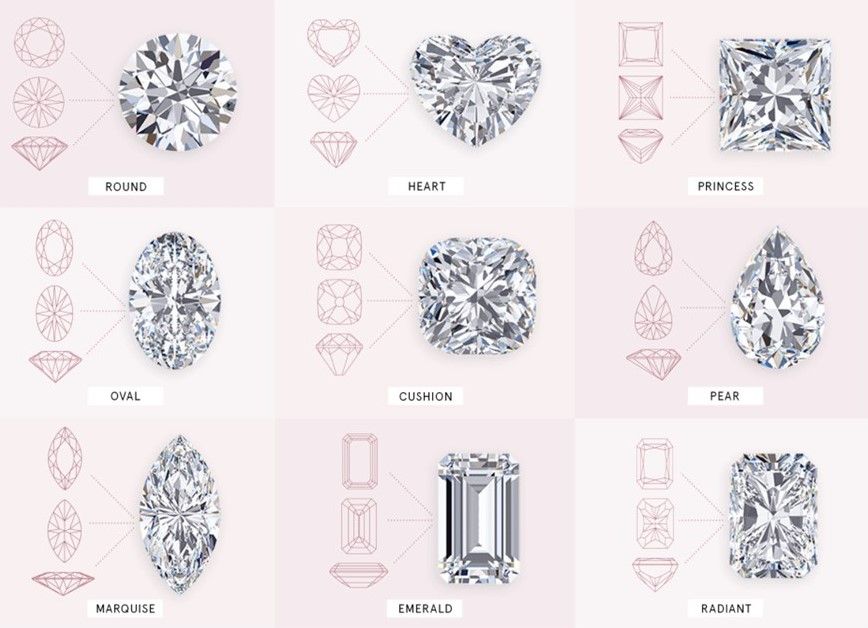+3232014770 / web@englanderworldwide.com
THE 4 C's OF DIAMONDS
When considering a diamond stone, there are a few factors to keep in mind to best determine quality and value. A good jeweler will be able to help you navigate a diamond collection, but having some knowledge under your belt will help you make the most informed decision possible and get the best value for your budget. There are four essential elements to consider when choosing a diamond, known as the four C's: Cut, Color, Clarity, and Carat weight. For some diamond buyers, carat weight is the most important factor, while others may put more emphasis on clarity and color. Each element has a basic rating system, but the personal value of the stone ultimately comes down to the qualities you find most important.
CUT
The cut of a diamond refers to its proportion, facets, and shape. As the most important source of sparkle, a properly cut and polished stone will reflect and disperse light to provide maximum shine. Cuts are typically graded on a 5-point scale from excellent to poor, depending on the amount of light that is reflected out of the stone. If a stone is cut too shallow or too deep, the light that passes through the crown escapes through the pavilion of the stone, hindering the desired sparkle. Girdle thickness is something to consider when determining the cut of a diamond, as a thicker girdle may be an indication of a poorly cut stone. A thicker girdle can also carry a higher carat weight that may not be reflected in the dimension of the stone, resulting in a smaller circumference but higher price tag. Depending on your budget, diamonds with lower color and clarity ratings can still provide high sparkle if they are cut in the right proportions and shape.
CLARITY
Diamond clarity is determined by the number of flaws, blemishes, and inclusions present in the stone. Inclusions are very small imperfections that naturally occur in the formation of diamonds and gemstones and interfere with the amount of light able to pass through the stone. Clarity ratings range from Flawless (FL) to Included (I). A higher clarity rating means the diamond has fewer inclusions and thus carries a higher price point. However, a slightly lower clarity rating can often times still look clean to the naked eye and radiate as much beauty. Diamond shape and cut will help determine the number of visible inclusions. Emerald-cut diamonds have a large table and a step-cut pavilion, which makes imperfections much more visible to the naked eye, and brilliant-cut diamonds feature multiple kite-shaped facets that can disguise inclusions.
COLOR
Natural diamonds can be found in a huge range of colors. For diamonds on the white scale, there is a color-rating system designed to categorize the stones from colorless to yellow. Diamond color on a scale from D to Z — D being completely colorless and Z being light yellow in color. A colorless diamond carries a higher value than a stone with a color presence. While the distinctions in color may be difficult to detect with the naked eye, they do have an impact on the price point of the stone. Diamond color is assessed by placing the stones on an all-white background, due to the color of a diamond becoming more difficult to detect once mounted in a ring setting. Additionally, metal color may make a difference in the way the diamond appears. If you're considering a diamond toward the yellow end of the spectrum, a yellow gold setting will help make the diamond appear whiter. The best way to determine if a diamond color meets your standards is to view the stone in person and in a well-lit space.
CARAT WEIGHT
Carat weight refers to the actual metric weight of the diamond, not to be confused with "karat," which refers to the measurement of purity in gold. The GIA defines "carat" as measuring 200 milligrams, or .02 grams. While carat weight is one of the largest determinants of price — larger carat diamonds tend to be rarer and more desirable — two diamonds of the same carat weight may vary greatly in price depending on other factors like the cut, color, and clarity grading. Keep in mind that two diamonds of the same carat weight can also appear to be different sizes depending on the quality of the cut.





